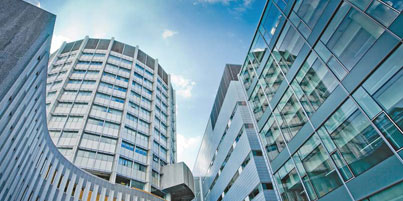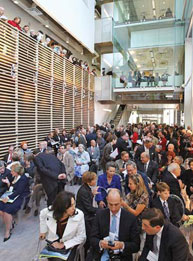 With the September 18, 2008 opening of the McGill University Life Sciences Complex, McGill began a new chapter of innovative interdisciplinary research.
With the September 18, 2008 opening of the McGill University Life Sciences Complex, McGill began a new chapter of innovative interdisciplinary research.
The 340,000-square-foot complex—which, with a $73.2-million price tag, is the biggest construction project in McGill history—links the extensively renovated McIntyre Medical and Stewart Biology buildings to two new buildings: the McGill Cancer Research Building and the Francesco Bellini Life Sciences Building. Francesco Bellini is the co-founder of BioChem Pharma, the Montreal company that helped bring 3TC, the first anti-HIV compound drug, to the public.
Physically joining the four buildings—collectively home to over 2,000 researchers, technical personnel, graduate students and postdoctoral fellows—is important to the LSC philosophy, which holds that working in close quarters is crucial for nurturing the free flow of information across diverse fields and speeding the rate of life-saving discovery.
“We’re entering into an exciting venture that amplifies our strengths in biological and medical research,” says Dr. Richard Levin, Vice-Principal (Health Affairs) and dean of the Faculty of Medicine. “The Life Sciences Complex lays the foundation for medical and scientific researchers to uncover the biological basis of disease, translate research into better health and patient care and train tomorrow’s leaders in the health sciences.”

“This is an enterprise which brings the best of McGill under one roof,” adds Martin Grant, Dean of the Faculty of Science. “It unites Science and Medicine and brings pure research together with the quest for practical applications.” The Bellini Building, for example, is shared by biology, biochemistry and physiology researchers, as well as scientists in the Centre for the Study of Host Resistance. On the same note, the LSC brings together the McGill Cancer Centre (established in 1989) with the Molecular Oncology Group to create the new Rosalind and Morris Goodman Cancer Centre; this expanded centre includes facilities in the Cancer Research and McIntyre Medical buildings. Morris Goodman co-founded the Montreal-based Pharmascience Inc. The Goodmans have also endowed a new chair in cancer research.
In addition to consolidating existing McGill talent, the LSC is attracting new brainpower to the University. Professor Paul Lasko says the LSC is already luring international top-drawer talent, citing the arrival of professors Nam-Sung Moon and Gary J. Brouhard, formerly of Harvard University and the Max Planck Institute of Molecular Cell Biology and Genetics, respectively. “We didn’t even interview people like that before we got this new facility,” says Lasko, leader of the Developmental Biology Research Initiative and chair of McGill’s Department of Biology. “We didn’t feel that we were competitive.”
The Life Sciences Complex isn’t just dedicated to improving human health, either. McGill’s Senate Sub-Committee on the Environment helped shape the design of the new buildings, giving careful consideration to “green” issues of sustainability, water efficiency, energy use and construction.
This project received funding from the Government of Quebec and the Canada Foundation for Innovation.
